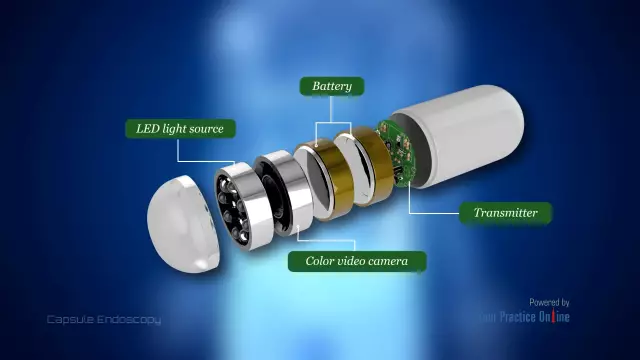- Author Rachel Wainwright [email protected].
- Public 2023-12-15 07:39.
- Last modified 2025-11-02 20:14.
Fescetam
Fescetam: instructions for use and reviews
- 1. Release form and composition
- 2. Pharmacological properties
- 3. Indications for use
- 4. Contraindications
- 5. Method of application and dosage
- 6. Side effects
- 7. Overdose
- 8. Special instructions
- 9. Application during pregnancy and lactation
- 10. Use in childhood
- 11. In case of impaired renal function
- 12. For violations of liver function
- 13. Use in the elderly
- 14. Drug interactions
- 15. Analogs
- 16. Terms and conditions of storage
- 17. Terms of dispensing from pharmacies
- 18. Reviews
- 19. Price in pharmacies
Latin name: Fescetam
ATX code: N06BX
Active ingredient: piracetam (Piracetam), cinnarizine (Cinnarizine)
Manufacturer: Adipharm EAD (Bulgaria)
Description and photo update: 2020-10-03
Prices in pharmacies: from 218 rubles.
Buy

Fescetam is a nootropic drug.
Release form and composition
Dosage form - capsules: cylindrical, white, solid, size No. 0; contents - a powdery mixture of almost white or white color, may contain conglomerates, which, when pressed, turn into powder (in a cardboard box, instructions for the use of Fescetam and 4 blisters containing 15 capsules each, or 6 blisters containing 10 capsules each).
Composition of 1 capsule:
- active ingredients: piracetam - 400 mg, cinnarizine - 25 mg;
- auxiliary components: colloidal anhydrous silicon dioxide, magnesium stearate, starlak (corn starch -15%, lactose monohydrate - 85%); capsule shell - gelatin, titanium dioxide.
Pharmacological properties
Pharmacodynamics
Fescetam is a combination drug that has a pronounced nootropic, antihypoxic and vasoconstrictor effect. Active components, potentiating the action of each other, reduce the resistance of the vessels of the brain and increase the blood flow in them.
The properties of the active ingredients of Fescetam:
- piracetam is a nootropic agent. It accelerates the utilization of glucose, enhances protein and energy metabolism, increases the resistance of cells to hypoxia, thereby activating metabolic processes in the brain. In the central nervous system, it improves interneuronal transmission, in the ischemic zone - regional blood flow;
- cinnarizine is a selective slow calcium channel blocker. Suppresses the flow of calcium ions into cells, reduces their amount in the plasmolemma depot. Reduces the tone of smooth muscles of arterioles and their reactions to biogenic vasoconstrictors (vasopressin, dopamine, epinephrine, angiotensin, norepinephrine). It has a vasodilating effect, especially on the vessels of the brain, as a result of which it enhances the antihypoxic effect of piracetam. At the same time, it has no significant effect on blood pressure indicators. It has a moderate antihistamine activity, reduces the excitability of the vestibular apparatus and the tone of the sympathetic nervous system. Reduces blood viscosity, increases the elasticity of erythrocyte membranes.
Pharmacokinetics
Suction
After oral administration, both active substances of Fescetam are almost completely absorbed in the gastrointestinal tract.
Piracetam reaches its maximum plasma concentration (C max) within 2-6 hours. Its bioavailability is 100%.
Cinnarizine is absorbed slowly. C max reaches within 1-4 hours. In an acidic environment, the bioavailability of the substance increases.
Distribution
Piracetam does not bind to blood plasma proteins. The apparent volume of distribution (V d) is about 0.6 l / kg. Easily penetrates into all organs and tissues, through the blood-brain and placental barriers, as well as through the filtering membranes used in hemodialysis. In the cerebrospinal fluid C max is noted after 2-8 hours. The drug is selectively accumulated in the cerebral cortex, mainly in the cerebellum, basal ganglia, occipital, frontal and parietal lobes.
Cinnarizine weakly binds to plasma proteins (9%). After 1-4 hours after ingestion, it is found in the brain, heart, kidneys, liver, spleen, lungs.
Metabolism
Piracetam practically does not undergo a biotransformation process.
Cinnarizine is actively and completely metabolized in the liver with the participation of the isoenzyme CYP2D6 by dealkylation. The metabolic process of the drug begins approximately 0.5 hours after ingestion.
Withdrawal
At least 80% of piracetam is excreted unchanged by renal filtration. In healthy volunteers, renal clearance is 86 ml / min. The half-life (T 1/2) from blood plasma is 4-5 hours, with renal failure this period is lengthened. In liver failure, the pharmacokinetic parameters of piracetam do not change.
Cinnarizine metabolites are excreted as follows: ⅔ - through the intestines, ⅓ - by the kidneys. T 1/2 is 4 hours.
Indications for use
- asthenic syndrome;
- psychoorganic syndrome with a predominance of symptoms of asthenia and adynamia;
- insufficiency of cerebral circulation in encephalopathies of various origins, atherosclerosis of cerebral vessels, after craniocerebral trauma, in the recovery period after ischemic and hemorrhagic strokes;
- Meniere's syndrome;
- labyrinthopathy (nystagmus, tinnitus, dizziness, nausea, vomiting);
- kinetosis (prevention).
Contraindications
Absolute:
- hemorrhagic stroke;
- chorea of Huntington;
- psychomotor agitation;
- severe renal dysfunction [creatinine clearance (CC) <20 ml / min];
- severe liver failure (> 9 points on the Child-Pugh scale);
- lactase deficiency, glucose-galactose malabsorption, galactose intolerance;
- children under 5 years old;
- During pregnancy and breastfeeding;
- hypersensitivity to any component of the drug.
Relative (Fescetam should be used with caution):
- increased intraocular pressure;
- arterial hypertension;
- Parkinson's disease;
- heavy bleeding;
- disorders of hemostasis;
- mild to moderate liver failure (<9 points on the Child-Pugh scale);
- renal failure with CC> 20 ml / min.
Fescetam, instructions for use: method and dosage
Fescetam capsules should be taken orally. Meal time does not matter.
Recommended dosage regimens:
- children over 5 years old - 1-2 capsules 1-2 times a day for a course of up to 3 months;
- adults: 1-2 capsules 3 times a day for 1-3 months.
For patients with CC less than 60 ml / min, the daily dose of the drug is reduced or the interval between doses is increased.
Side effects
- from the central nervous system and psyche: drowsiness, nervousness, hyperkinesia, depression, increased sexual activity; in rare cases - headaches, insomnia, hallucinations, agitation, dizziness, anxiety, confusion, imbalance, ataxia;
- from the digestive system: rarely - abdominal pain, increased salivation, diarrhea, nausea, vomiting;
- allergic reactions: very rarely - photosensitivity, itching, dermatitis, skin rash, edema.
In elderly patients, with prolonged use of Fescetam, there is a possibility of tremor.
Overdose
Information on Fescetam overdose is limited. In known cases, there were no serious side effects requiring discontinuation of therapy.
In adults, disorders of the gastrointestinal tract were most often observed.
The following symptoms prevailed in children: irritability, anxiety, tremors, insomnia, euphoria. On rare occasions, hallucinations and nightmares have occurred.
After taking an excessive dose of Fescetam, it is recommended to induce vomiting and gastric lavage. Treatment of unwanted symptoms is symptomatic. If necessary, hemodialysis is performed. There is no specific antidote.
special instructions
During the period of treatment with Fescetam, it is recommended to refrain from drinking alcohol.
Influence on the ability to drive vehicles and complex mechanisms
Fescetam can cause side effects such as drowsiness and dizziness, therefore, during therapy, you should refrain from performing potentially hazardous activities, including driving.
Application during pregnancy and lactation
No controlled studies have been conducted on the safety of piracetam when used during pregnancy. Therefore, the drug is contraindicated, except in cases of absolute necessity of its appointment, when the benefits outweigh the possible risks.
Piracetam passes into breast milk. And although a negative effect on the child in experimental studies has not been identified, during lactation Fescetam can be used only in cases of urgent need.
Pediatric use
Fescetam capsules are not used to treat children under the age of 5 years.
With impaired renal function
The nootropic agent is contraindicated in patients with severe functional impairment of the kidneys (CC <20 ml / min).
With mild and moderate impairment of renal function (CC <60 ml / min), the daily dose of the drug is reduced or the intervals between doses are increased.
For violations of liver function
The drug is contraindicated in patients with severe hepatic impairment (> 9 points on the Child-Pugh scale).
In case of mild and moderate impairment of liver function during the period of therapy, the activity of liver enzymes should be monitored.
Use in the elderly
There are no specific recommendations for the dosage regimen of Fescetam for the elderly.
Drug interactions
Fescetam can enhance the effects of ethanol, tricyclic antidepressants, oral anticoagulants, antihypertensive drugs, nootropic drugs.
It also enhances the sedative effect of drugs that have a depressing effect on the central nervous system.
Improves the tolerance of tricyclic antidepressants and antipsychotics.
The effect of the drug may be enhanced by vasodilators.
Analogs
Fescetam analogs are Amilonosar, Betaserc Kombi, Vinpocetin Velpharm, Gliatilin, Gopantam, Hopantenic acid, Idebenon, Quinel, Calcium hopantenat, Cortexin, Lucetam, Neuromet, Noopept, Omaron, Pantogam, Semaxocybital, Piracetamit, Piracetamit, Cerebrolysate, Encephabol, etc.
Terms and conditions of storage
Keep out of reach of children at temperatures up to 25 ° C.
The shelf life is 3 years.
Terms of dispensing from pharmacies
Dispensed by prescription.
Reviews about Fescetam
There are no reviews on specialized sites directly about Fescetam. About its complete analogue of active substances and their content - Phezame - the reviews are mostly positive. The drug improves cerebral circulation, due to which dizziness decreases, tinnitus passes, memory and attention improve, and a surge of strength is felt.
Price for Fescetam in pharmacies
The price of Fescetam in capsule form is approximately 255-365 rubles. per pack of 60 pcs.
Fescetam: prices in online pharmacies
|
Drug name Price Pharmacy |
|
Fescetam 400 mg + 25 mg capsules 60 pcs. RUB 218 Buy |
|
Fescetam capsules 400mg + 25mg 60 pcs. 277 r Buy |

Anna Kozlova Medical journalist About the author
Education: Rostov State Medical University, specialty "General Medicine".
Information about the drug is generalized, provided for informational purposes only and does not replace the official instructions. Self-medication is hazardous to health!






